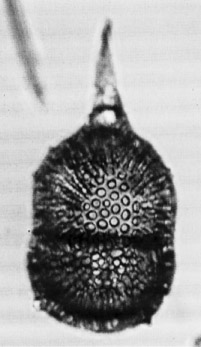 Lychnocanoma
amphitrite Foreman
Lychnocanoma
amphitrite Foreman Lychnocanoma
amphitrite Foreman
Lychnocanoma
amphitrite ForemanLychnocanoma amphitrite Foreman, 1973, p.437, pl.11, fig.10
Cephalis and thorax similar to L. bellum. Differs in larger size and more massive wall of thorax and relatively shorter feet. Third segment triangular in cross-section, inverted subhemispherical to pyramidal, with very irregular pores. Hollow feet incorporated in shell wall except distally where they protrude outwardly, solid, short, stubby, and bladed (Foreman, 1973).
Based on 20 specimens. Length overall, exclusive of horn 190-280 µm, length of cephalis and thorax 140-175 µm, of abdomen 40-110 µm; greatest width of thorax 150-190 µm (Foreman, 1973).
Thorax large, hemispherical. Abdomen inverted-hemispherical, with very irregular pores. Three hollow feet mostly incorporated in abdominal wall, distally usually free (Riedel and Sanfilippo, 1978a).
Later specimens tend to have the horn become slightly bladed, and very late specimens...have a less robust abdomen with the feet less integrated into the shell wall. Sometimes only a fragment of the third segment is present at the base of the feet (Foreman, 1973).
Specimens have been found where the spongy-walled abdomen is so dense that the hollow feet incorporated in the wall are difficult to discern. A spongy layer may cover the thorax as well (Sanfilippo, unpubl. data).
This species is found in late Eocene sediments from all oceans. In low latitudes its morphotypic first appearance lies within the Cryptocarpium azyx Zone, but in high latitudes its first occurrence is earlier, in the early Eocene. Its morphotypic last appearance lies within the Theocyrtis tuberosa Zone.